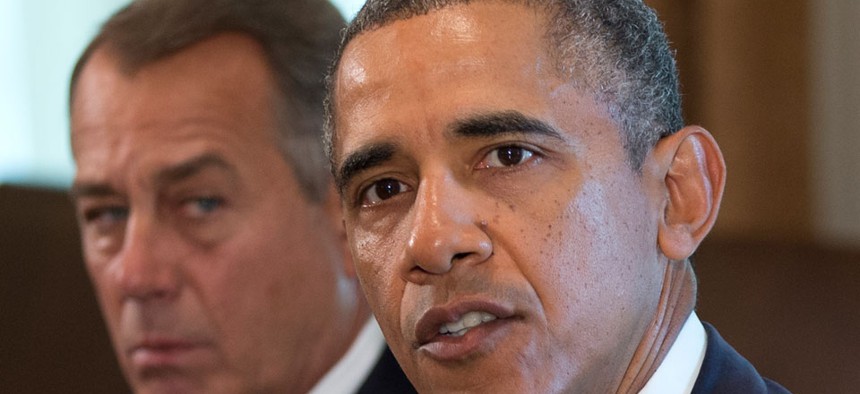
Carolyn Kaster/AP file photo
Six Ways Washington Will Stay the Same
What will happen after the midterm elections in November?
Political aficionados like to look at elections the same way sports fans fill out their NCAA basketball brackets, assemble a fantasy football team, or play rotisserie baseball.
The real import is what the final governing configuration will be after Election Day: Which party will control the House? Who will hold a majority in the Senate? What will Congress look like for the remainder of President Obama's term? What kind of relationship will Obama have with Congress? How much political clout will the president have? Ultimately, these are the questions that really matter.
With this in mind, here are six assumptions that seem reasonably safe over the next few years.
1. The first, and the safest, is that the House will remain in Republican hands in 2016 and, quite likely, at least until 2022. After the 2020 decennial census and subsequent reapportionment and redistricting in 2021, all will be revisited again, but it would take some profound political developments for Republicans' hold on the chamber to change before then. Redistricting isn't the only reason for what has happened in the House, but it explains it well enough. The biggest question about 2014 is whether the GOP will score a net gain of eight seats or more, something that Cook Political Report House Editor David Wasserman points out would result in Republicans holding their largest overall share of House seats since the 267-163 seat majority they held in the 71st Congress. (It would take a 33-seat gain for Republicans to best that Congress and hit their all-time high).
2. The Senate--currently split among 55 Democrats and 45 Republicans--will be very closely divided after the 2014 election and could swing to the other side in 2014 and again in 2016. It's hard to see how the GOP doesn't score a net gain of at least four seats, shaving the Democratic majority to 51 seats. At the other extreme, it would not be impossible for Republicans to score a net gain of seven or eight seats, giving the GOP a 52-48 majority, or even one of 53-47. The odds are high after this election that the majority party will have 53 seats or less, but it is important to remember that in 2016, the shoe will be on the other foot in terms of seat exposure. This year, Democrats have 21 seats up, compared with 15 for Republicans; in 2016, the GOP will have 24 seats up, while Democrats will only have 10. It's not implausible that Republicans could pick up a majority in 2014 only to lose it again in 2016, with the Senate teetering on the edge for the foreseeable future.
3. President Obama's job-approval ratings are very likely to remain pretty much where they are today, which means he will be running pretty low on political capital. His approval generally oscillates between 38 and 46 percent in most polls, with disapproval usually between 50 and 54 percent (looking only at polls using live interviewers). Obama's approval ratings have ranged from as low as 38 percent in Fox and occasional Gallup nightly tracking to as high as 46 percent in polling by ABC News/Washington Post, CBS News/New York Times, and at times, Gallup. Most often, the president's approval rating runs around 41 percent, as NBC News/Wall Street Journal and the most recent CBS/NYT poll found. Obama's disapproval numbers have run from as low as 47 percent in older CBS News polls to as high as 54 percent in NBC/WSJ's and Fox's polling (there is a Bloomberg News poll that was something of an outlier that showed 48 percent for both approval and disapproval of the president). The most recent (March 14-16) Gallup tracking shows 40 percent approval, 55 percent disapproval. If Obama were a stock, you would say he has a narrow trading range, with a high floor and a low ceiling. Barring some cataclysmic event, his approval is unlikely to stay below 38 percent or above 46 percent for long, meaning that his political capital will remain pretty low for the duration of his presidency.
4. Obama's relations with Congress will remain poor for the duration of his time in office, pretty much as they have been since his earliest days in the White House. More specifically, Obama and his White House have no relationship at all with the tea party and most conservative Republicans on Capitol Hill, an awful relationship with the more establishment Republicans, and a distant and uncomfortable relationship with congressional Democrats. Perhaps the title of the movie He's Just Not That Into You pretty much describes how the president's attitude toward his own party members seems to be, and their view of him has become pretty much reciprocal. It's hard to see how any of that changes either before or after the 2014 midterms.
5. To the extent that Congress and the president are unable to agree on much legislatively, the Obama administration will try as much as possible to affect policy through regulatory and administrative means. This in turn is likely to set up even more fights with Congress.
6. Finally, to the extent that Washington isn't able to agree on and do much on some issues, state governments will attempt to step into the breach and address the issues themselves when they can. That being said, some of the worst elements of partisanship and fighting in D.C. seem to be infecting more state capitals.
The bottom line is that if you have liked the last three years, you'll love the next three. If you haven't liked the last three years, you'll just have to suck it up; it isn't likely to change anytime soon.






